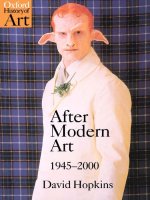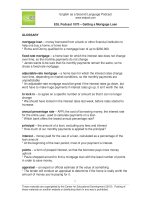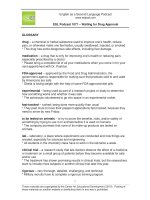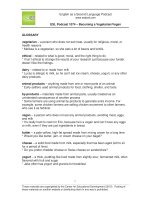ESL podcast 894 understanding modern art
Bạn đang xem bản rút gọn của tài liệu. Xem và tải ngay bản đầy đủ của tài liệu tại đây (90.19 KB, 9 trang )
English as a Second Language Podcast
www.eslpod.com
ESL Podcast 894 – Understanding Modern Art
GLOSSARY
artwork – creative pieces created by someone to express an idea or bring joy to
others, such as paintings, sculptures, and drawings
* This apartment would feel more like a home if you put some artwork on the
walls.
experimental – trying something for the first time to see whether it will work or
be successful; testing of a new idea
* Derek designed an experimental car that runs on cooking oil instead of
gasoline.
abstract – with images that do not look like real objects, but instead are not
clearly seen or are based on imagination
* Pablo Picasso created many famous abstract portraits.
performance art – a type of drama or acting combined with visual pieces of art
* They’re using performance art to express their feelings of grief.
perception – viewpoint; how one views, sees, interprets, or understands
something
* Our sense of smell plays a significant role in our perception of taste.
reality – real life; how the world really is and what actually happens
* Sheila thought getting a job and living on her own would be glamorous, but the
reality was much more challenging than she had ever imagined.
contemporary art – modern art; art that has been produced recently, maybe
since the end of World War II
* The Tate Museum in London features contemporary art.
to represent – to symbolize; to have a meaning beyond the normal appearance
of something; to serve as a symbol or sign of something else
* Lynn wears a pink ribbon that represents her support of the fight against breast
cancer.
interpretation – how one perceives and understands something and then
expresses it to others
* The orchestra is rehearsing a new interpretation of C.P.E. Bach’s Symphony
No.1 in D.
1
These materials are copyrighted by the Center for Educational Development (2013). Posting of
these materials on another website or distributing them in any way is prohibited.
English as a Second Language Podcast
www.eslpod.com
ESL Podcast 894 – Understanding Modern Art
to oppress – to treat someone unfairly and cruelly and not offer that person
opportunities to succeed or improve his or her lifestyle
* Throughout history, many cultures have oppressed women and minorities.
postmodern – relating to things that were developed in the style following
modernism, especially with a skeptical (questioning) interpretation of the world
* Many postmodernists believe there is no such thing as absolute truth, only
one’s perception and interpretation of the world.
cut out for – prepared for something; ready to have, do, or understand
something; made for something
* Juniper has studied piano for years, but she just isn’t cut out for a job as a
professional pianist.
representational – showing the physical appearance of things the way they
actually are, not as someone imagines or interprets them
* Representational portraits are really difficult. No matter how hard I try to paint
well, the portrait never truly looks like the person I’m trying to paint.
to wrap (one’s) head around (something) – to be able to understand
something, especially something that is very complex and far-reaching
* I just can’t wrap my head around the great distances in outer space.
underrated – underappreciated; placing less value on something than what it
actually deserves; not recognizing the true value or importance of something
* Everyone underrated the new CEO’s ability to turn the company around and
become successful again.
paint-by-numbers – a type of painting, normally for children, where a drawing is
divided into many sections, with instructions to paint each section a particular
color based on the number printed inside it
* The teacher created a paint-by-numbers handout where the students have to
solve math problems to figure out which color to paint each section.
2
These materials are copyrighted by the Center for Educational Development (2013). Posting of
these materials on another website or distributing them in any way is prohibited.
English as a Second Language Podcast
www.eslpod.com
ESL Podcast 894 – Understanding Modern Art
COMPREHENSION QUESTIONS
1. What does Livia hope her artwork will do?
a) She hopes it will change how people think about the real world.
b) She hopes it will challenge people’s beliefs and make them feel
uncomfortable.
c) She hopes it will bring joy to the people who see it.
2. What does Stephan mean when he says, “I don’t think I’m cut out for modern
art”?
a) He can’t afford to buy modern art.
b) He isn’t talented enough to create modern art.
c) He doesn’t understand modern art.
______________
WHAT ELSE DOES IT MEAN?
abstract
The word “abstract,” in this podcast, means with images that do not look like real
objects, but instead are unclear or are based on imagination: “I like abstract
paintings, but this one just looks like a swirl of colors.” Something that is
“abstract” can also be something based on ideas or theory instead of real events
or examples: “Davi described his plan in abstract terms, but he didn’t provide any
numbers.” Finally, as a noun, an “abstract” is a short piece of writing that
summarizes the most important information in an academic article: “Quentin
spent hours reading journal abstracts, trying to find the right kinds of research to
use as references in his research paper.”
to be cut out for
In this podcast, the phrase “to be cut out for” means to be prepared for
something, or to be ready to have, do, or understand something: “Do you think
you’re cut out for fatherhood?” The phrase “to cut (someone) off” means to stop
giving someone something, especially alcohol: “Bartenders are required to cut
customers off if they’ve had too much to drink.” The phrase “to cut (someone) off”
also means to stop providing a service: “The electric company is going to cut us
off if we don’t pay the bill by the end of the day.” Finally, the phrase “to not cut it”
means to not be good enough for something: “Victor dreamed of being a rock
musician, but he just couldn’t cut it.”
3
These materials are copyrighted by the Center for Educational Development (2013). Posting of
these materials on another website or distributing them in any way is prohibited.
English as a Second Language Podcast
www.eslpod.com
ESL Podcast 894 – Understanding Modern Art
CULTURE NOTE
Pop Art
“Pop art” describes a style of art that “emerged” (began to appear) in the 1950s.
It uses many images from popular culture, such as “ads” (advertisements; printed
pieces used to encourage people to buy something) and news articles. Pop art is
based on images that are “accessible” (can be related to) by all people, not just
by the “elite” (the wealthiest, most privileged members of society) art “circles”
(groups of people who have many shared interests).
“Andy Warhol” was a “major” (important) “figure” (well-known person) in pop art
in the United States. He painted many “iconic objects” (things that represent a big
idea) that were important in American culture. He often painted “celebrities”
(famous singers, actors, and athletes), like Marilyn Monroe and Elvis Presley.
And he also painted things like U.S. dollar bills, cans of Campbell’s soup, and
bottles of Coca-Cola. He often used bright, surprising colors.
Roy Lichtenstein was another important figure in the American pop art
movements. He mostly used “comic books” (short, inexpensive books that tell
stories with many images and few words) and advertisements as a source of
“inspiration” (where an artist finds ideas for new work). Many of his pieces look
like “comic strips” (a rectangular group of images in a comic book) or page from a
comic book, with many small dots that are placed close together or far apart to
affect the viewer’s perception of color. He also re-created some of the great
“masterpieces” (the most famous and best pieces of art), like those by Van Gogh
and Picasso, in his comic book style.
______________
Comprehension Questions Correct Answers: 1 – a; 2 – c
4
These materials are copyrighted by the Center for Educational Development (2013). Posting of
these materials on another website or distributing them in any way is prohibited.
English as a Second Language Podcast
www.eslpod.com
ESL Podcast 894 – Understanding Modern Art
COMPLETE TRANSCRIPT
Welcome to English as a Second Language Podcast number 894: Understanding
Modern Art.
This is English as a Second Language Podcast episode 894. I'm your host, Dr.
Jeff McQuillan, coming to you from the Center for Educational Development in
beautiful, and I do mean beautiful, Los Angeles, California.
We have a website. Yes, we do. We have a website. How about you? Well, our
website is ESLPod.com and if you go there, you can become a member of ESL
Podcast and download the Learning Guide for this episode.
This episode is about understanding modern art, something many of us have a
difficult time doing. We’ll listen to a dialogue between Stephan and Livia. Let's get
started.
[start of story]
Stephan: What’s that?
Livia: It’s my latest artwork. It’s experimental.
Stephan: It’s, um...
Livia: Abstract. It’s part of a performance art piece I’m putting together. It’ll really
challenge people’s perceptions of reality.
Stephan: I don’t really understand contemporary art. Is it supposed to represent
something?
Livia: It’s my interpretation of how the rich oppress the poor.
Stephan: Really?
Livia: Yes, from a postmodern perspective.
Stephan: Oh, I see.
Livia: You do?
5
These materials are copyrighted by the Center for Educational Development (2013). Posting of
these materials on another website or distributing them in any way is prohibited.
English as a Second Language Podcast
www.eslpod.com
ESL Podcast 894 – Understanding Modern Art
Stephan: No, not really. I don’t think I’m cut out for modern art. I prefer art to be
representational. I just can’t wrap my head around this.
Livia: That’s the point. It’s supposed to challenge you and make you think.
Stephan: Well, it’s certainly made me think.
Livia: It has?
Stephan: Yeah, it’s made me realize that I’ve underrated paint-by-numbers all
these years.
[end of story]
Stephan begins our dialogue by asking Livia, “What's that?” What is that? Livia
says, “It's my latest artwork. It's experimental.” “Artwork” (artwork) – one word - is
anything that an artist creates that expresses his or her ideas. It could be a
painting. It could be a sculpture. It could be drawing. It could be film. Any of these
objects, any of these things, could be called artwork. Livia says that her artwork
is experimental. “Experimental” usually means something that is new, something
that hasn't been done before, something that perhaps you're not quite sure will
work.
Stephan says, “It's um...” He uses “um” to think of something to say. Of course,
he wants to say something nice but he's a little perhaps confused. Livia says
“abstract.” She’s describing what the artwork is. Stephan couldn't come up with
the name perhaps. So, Livia helps him by saying it's abstract art. “Abstract”
means, as imaginative – when we’re talking about art – objects that don't look
like real objects. They’re are not clearly seen. You have to use perhaps your
imagination to understand what the symbols or shapes or colors are saying to
you in the art.
Livia says, “It's part of a performance art piece I'm putting together.”
“Performance art” is really a kind of drama, kind of acting, a kind of series of
actions that make up the art piece. Performance art typically happens in a given
place and time, and if you're not there, then you can't experience the art. It's not
like art on the wall at a museum. I actually took a class in performance art, oh,
many years ago, back in the early 90’s. Performance art was very popular in Los
Angeles. There were a lot of well-known artists who came to Los Angeles to do
performance art and there are still places where you can go and see
performance art here in L.A. In fact, in Santa Monica, there is a place especially
for performance art.
6
These materials are copyrighted by the Center for Educational Development (2013). Posting of
these materials on another website or distributing them in any way is prohibited.
English as a Second Language Podcast
www.eslpod.com
ESL Podcast 894 – Understanding Modern Art
Well, Livia is talking about her performance art piece. “Piece,” here just means
artwork. Livia says, it will really challenge people’s “perception of reality.” Your
“perception of something” is how you view it, how you see it, how you interpret it.
“Reality” is that which is real, that which is true – real life – how the world really
is. Stephan says, “I don't really understand contemporary art.” “Contemporary”
here means the same as modern – art that has been produced recently. You can
use contemporary also as a noun, when describing a person who is the same
age or lived at the same time – is really what we're talking about – as another
person. So, we could say that F. Scott Fitzgerald and T.S. Eliot were
contemporaries. They lived at the same time. I'm not sure if they knew each
other. I don't think so.
Anyway, Stephan is talking about contemporary art, which is modern art, art of
our generation. Stephan says, “Is it supposed to represent something?” “To
represent,” in art, means to symbolize, to have a meaning beyond the normal
appearance of whatever the thing is. For example, you might have a rose in your
picture, in your painting, that represents love or represents goodness or passion
or whatever it is you're trying to communicate with the people looking at your art.
Livia says the artwork she made is “my interpretation of how the rich oppress the
poor.” “Interpretation” is how you, as an individual, understand something, how
you think it works, how you try to express it to another person. In art, your
interpretation is the way you see this particular piece of art being expressed.
Artists and actors will also talk about interpretation. “To interpret a role” means to
act a certain part in a play or movie or drama, and the idea here is that it is your
idea of what that performance should be, your interpretation of it. This artwork is
Livia's interpretation of how the rich oppress the poor. “To oppress” (oppress)
means to treat someone unfairly, to treat someone cruelly. It's not an art term. It's
a term really more common in politics or sociology. Livia is interested, however,
in expressing how the rich, people with a lot of money, oppress the poor, treat
the poor badly.
Stephan says, “Really?” which here means, “Is that true?” “Is that really true?”
Livia says, “Yes, from a postmodern perspective.” “Postmodern” is a term you will
see in many places, in philosophy and science and in art. It relates to things in art
that were developed in a style that came after modernism. “Post” (post) as a
prefix, means after. Postmodern art tends to have a very, how we might say,
“skeptical interpretation” of the world, a questioning interpretation of the world.
Stephan says, “Oh, I see.” Livia says, “You do?” Stephan says, “No. Not really,”
meaning I don't really see. I don't really understand. “I don't think I'm cut out for
7
These materials are copyrighted by the Center for Educational Development (2013). Posting of
these materials on another website or distributing them in any way is prohibited.
English as a Second Language Podcast
www.eslpod.com
ESL Podcast 894 – Understanding Modern Art
modern art,” Stephan says. “To be cut out for something” is a phrasal expression
meaning to be prepared for something, to be ready to have or ready to do
something. I don't think I'm cut out for playing the piano. I tried but I wasn't very
good. I really did. I tried once about five, six years, ago – didn't do very well. I'm
not cut out for playing the piano.
Stephan says, “I prefer art to be representational.” Something that is
“representational” is something that shows things the way they really are. When
you look at a painting, you can say, “Oh, yes. That's a car. That's a flower. That's
a mountain.” That is representational art. Stephan says, “I just can't wrap my
head around this.” “To wrap (wrap) your head around something” means to be
able to understand something, something that perhaps is very difficult or complex
– “to wrap your head around something.”
Stephan says he cannot wrap his head around Livia’s art. Livia says, “That's the
point,” meaning that's exactly what I'm trying to do. “It's supposed to challenge
you and make you think.” Stephen says, “Well, it certainly made me think.” Livia
says, “It has?” meaning it has made you think? Stephan says, “Yeah. It's made
me realize that I've underrated paint-by-numbers all these years.” “To underrate”
(underrate) means not to appreciate something the way you should, to consider
something less important or less valuable than what it really is. Stephan says he
underrated paint-by-numbers. “Paint-by-numbers” was a type of painting. Well, it
was a type of activity that was popular in oh, the 1970’s, when I was growing up.
Usually, it's something that children now do, not adults. Basically, you have a
picture, a drawing, and you have little numbers, and the numbers tell you what
colors should go in that little space. Children often color in things that are
numbered and have colors for them, at least they used to. I don't know. Maybe
they don't anymore. Even among adults, paint-by-numbers was a popular
activity, at least in the United States, during a certain period of time, as I say
back in the 1970’s. At least, that's what I remember.
Well, Stephan thinks that paint-by-numbers, which is not considered real art – it's
not considered art that you would put in a museum – Stephan is saying that that
kind of art, that paint-by-numbers art, maybe was better than he thought it was.
Of course, what he's doing here is he's insulting Livia. He’s saying that, that painby-numbers art is better than your professional art.
Now let’s listen to the dialogue this time, at a normal speed.
[start of story]
Stephan: What’s that?
8
These materials are copyrighted by the Center for Educational Development (2013). Posting of
these materials on another website or distributing them in any way is prohibited.
English as a Second Language Podcast
www.eslpod.com
ESL Podcast 894 – Understanding Modern Art
Livia: It’s my latest artwork. It’s experimental.
Stephan: It’s, um...
Livia: Abstract. It’s part of a performance art piece I’m putting together. It’ll really
challenge people’s perceptions of reality.
Stephan: I don’t really understand contemporary art. Is it supposed to represent
something?
Livia: It’s my interpretation of how the rich oppress the poor.
Stephan: Really?
Livia: Yes, from a postmodern perspective.
Stephan: Oh, I see.
Livia: You do?
Stephan: No, not really. I don’t think I’m cut out for modern art. I prefer art to be
representational. I just can’t wrap my head around this.
Livia: That’s the point. It’s supposed to challenge you and make you think.
Stephan: Well, it’s certainly made me think.
Livia: It has?
Stephan: Yeah, it’s made me realize that I’ve underrated paint-by-numbers all
these years.
[end of story]
She's definitely cut out for scriptwriting. I speak of our wonderful scriptwriter, Dr.
Lucy Tse. From Los Angeles, California, I'm Jeff McQuillan. Thank you for
listening. Come back and listen to us again right here on ESL Podcast.
English as a Second Language Podcast was written and produced by Dr. Lucy
Tse, hosted by Dr. Jeff McQUillan. Copyright 2013 by the Center for Educational
Development.
9
These materials are copyrighted by the Center for Educational Development (2013). Posting of
these materials on another website or distributing them in any way is prohibited.









